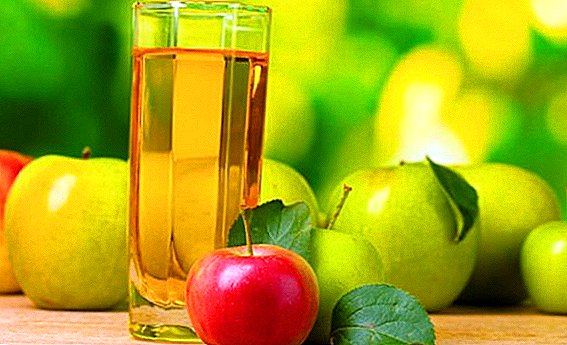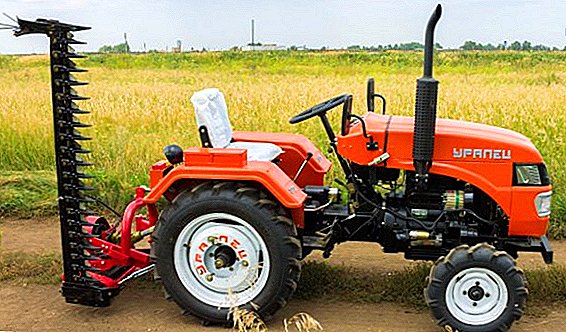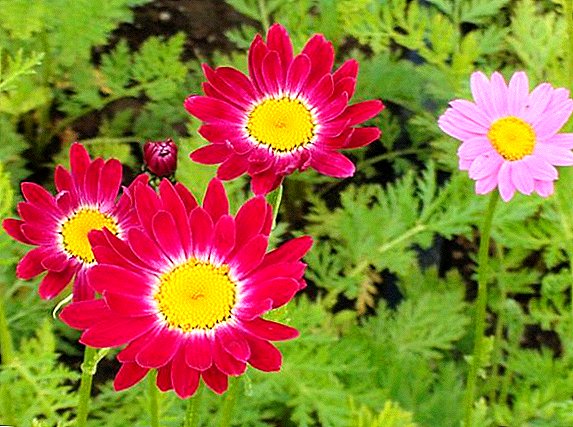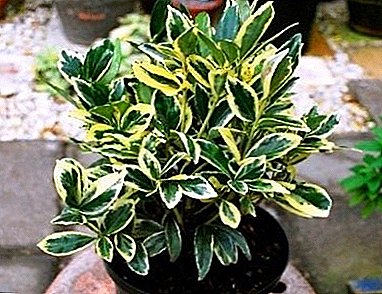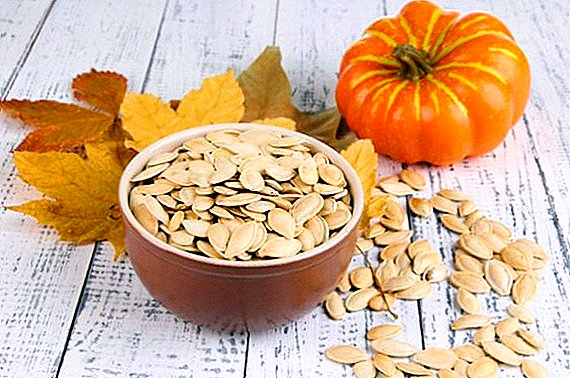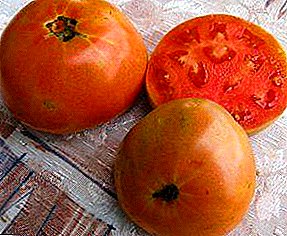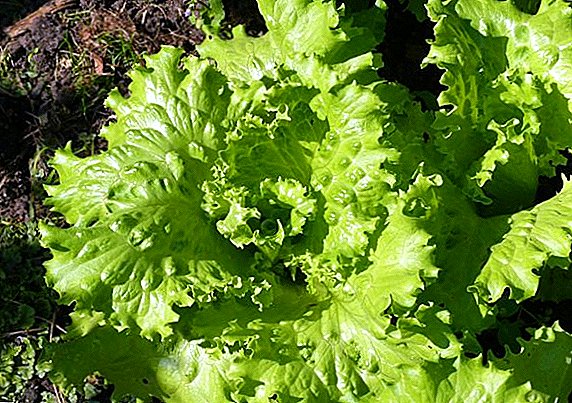 Crispy green lettuce is a wonderful ingredient in many dishes. If earlier we used much less greens, now the scale of growing salad crops is increasing, and they are increasingly appearing on our table.
Crispy green lettuce is a wonderful ingredient in many dishes. If earlier we used much less greens, now the scale of growing salad crops is increasing, and they are increasingly appearing on our table.
And if everything is familiar with lettuce that is lettuce, some find it difficult to answer. In fact, lettuce is a synonym for lettuce, a vegetable plant that can be grown on your site without any problems.
Lettuce: description and biological features of lettuce
Lettuce, or salad, - genus of flowering plants of the Astrovye family, which includes 147 species. Of these, food is used lettuce, or lettuce, other types are weeds. Cultivated all over the world.
This is an annual, early-ripening plant with a taproot, sessile leaves, yellow inflorescences-baskets and fruit-seed. The characteristics of the product organs (leaves or heads) depend on the variety and variety of lettuce. Lettuce leaves come in different shapes and colors, sometimes with anthocyanin coloring.
Used in cooking as a vitamin greens for salads, sandwiches, snacks and other dishes. Lettuce has many beneficial properties: improves appetite and digestion, has a positive effect on the body during obesity, pregnancy, exhaustion, anemia. For food use leaves, cabbages, thickened stems. The leaves are edible until the plant creates the stem, after which they lose their taste. 
Lettuce is known as a vegetable, but not everyone knows that this plant has a healing effect. Infusion of fresh leaves is used as a sedative, antispasmodic, hypnotic, from the juice of lettuce prepare a homeopathic medicine for diseases of the cardiovascular system.
Did you know? The genus name in Latin (Lactuca) is derived from the Latin word "milk" ("lac"). When the stems and leaves of the plant are damaged, white juice is released, which served as the title.
Types and varieties of lettuce salad
Lettuce is represented by several varieties:
- Lactuca sativa var. secalina - leaf lettuce with heavily dissected leaves, has many varieties, some of them are: Raspberry Ball, Levistro, Constance, Concord, Record, Little Krasny, Anthony, Rubett, Green Coral, Red Coral, Grenada, Kucheryavets Odessa.
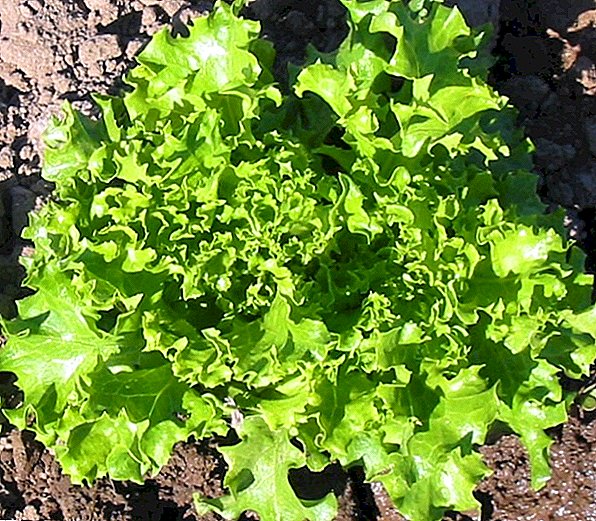
Ukrainian variety Snowflake is early maturing (20-25 days). Relatively resistant to drought, high humidity and cold, resistant to diseases. Productivity - 1.05-2 kg / sq. The large semi-upright outlet 30–35 cm high and 20–25 cm in diameter consists of 12–18 leaves. The leaves are thick, whole, wide and oval, yellowish in color. The plant is decorative.
Golden Ball - Ukrainian medium early variety (25-30 days). In a compact outlet with a diameter of 22-24 cm there are 10-14 whole yellowish leaves of medium thickness, wavy along the edges. The salad is decorative, whole leaves are used as decoration of the dish.
- Lactuca sativa var. acephala - Sheet-leaf salad with whole leaves. This species is suitable for gradual harvesting: the outer leaves are cut, the inner (young) leaves to grow. Grades: Lollo Blonda, Lollo Rossa, Lollo bionda, Lollo Gorbi.
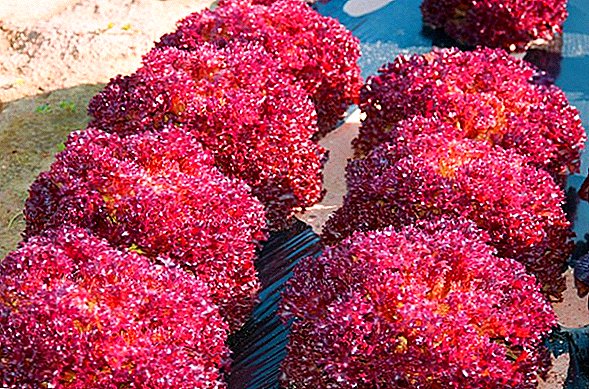
Lollo rossa - a popular mid-season variety (40-55 days), very decorative, resistant to bolting. The leaves are large, crispy, curly, light green with a red-pink edge. Variety is often used to decorate flower beds. Plant weight - 325 g, yield - 3.0 kg / sq. m
- Lactuca sativa var. capitata - cabbage salad with broad buttery or crispy leaves. The market is represented by varieties Etti, Olzhich, Godard, Major, Senator, Laravera.
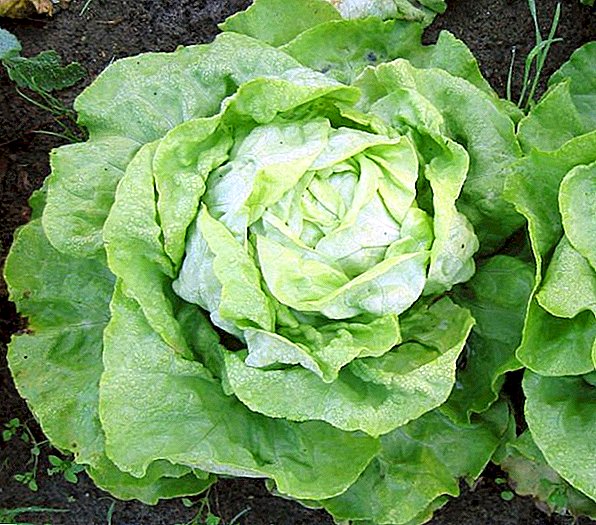
Olzhich - Ukrainian medium late variety (40-46 days) with a rounded head, delicate oily grayish-green leaves. The yield of lettuce - 2.5-3.2 kg / sq. m
- Lactuca sativa var. longifolia - Roman salad (romain), characterized by an elongated-oval head and a rosette of raised leaves.
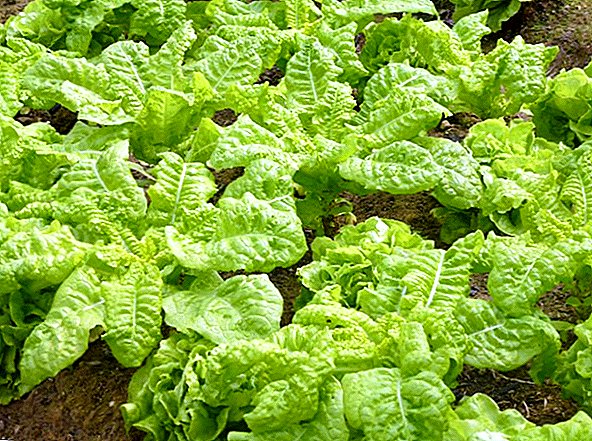
Ukrainian variety Skarb created as a result of selection of the Spanish sample Romana rorogorana and the Algerian Varte maraihere at the experimental station "Mayak" of the Institute of Vegetable and Melon-growing, National Academy of Agrarian Sciences of Ukraine. Variety resistant to drought. The salad has a large oval-shaped head, the leaves are thick, erect, oval-shaped and dark green in color, with an undissected edge. The weight of the lettuce head is 556.0 g. The period from germination to marketability is 48 days. The yield of the variety - 3.2 kg / sq. m
- Lactuca sativa var. angustana (var. asparagina) - Stem (asparagus) lettuce, characterized by a thick stem and long, narrow, smooth leaves at the edges. Annual plant with a height of 60-120 cm. Cold-resistant culture, the seeds of which begin to grow at a temperature of 2-5 ° C and withstand slight frosts. Sown from April to June. Difficult tolerates drought of any degree.
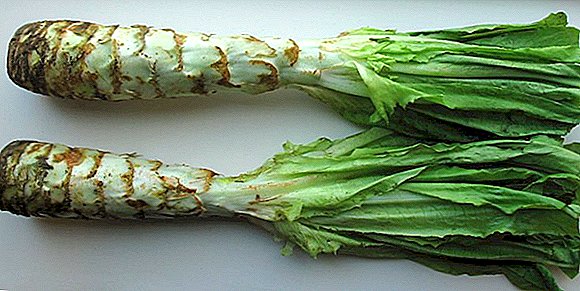
Variety of Ukrainian selection Pogonych It has a high yield and excellent taste. The length of the stem - 25-40 cm, leaves - 17 cm, in the outlet 11 leaves. The leaves are of medium thickness, gray-green, oval, erect. The mass of the stem - 310 g, rosettes of leaves - 750 g. The yield of green - 5.32 kg / sq. m, stems - 2.18 kg / sq. m
Important! Modern economic and consumer classification of varieties of lettuce divides them into oily and crispy cabbage varieties, Roman lettuce (Romain), Latin lettuce (grass), shear and stem lettuce.
The choice of location and soil
Lettuce is suitable for cultivation in open and protected ground.
Salad feels better on a sunny place where there are no drafts. It is not necessary to plant it near high vegetables, which create abundant shade.
For the lettuce perfectly suitable fertile drained soil with a neutral or slightly acid reaction. Fertilizer concentration should not be too high. Green lettuce can accumulate nitrates, so you do not need to abuse nitrogen fertilizers.
Did you know? The consumption rate of lettuce is at least 5 kg per person per year. The British and French have long exceeded this figure, for the year in these countries eaten 14 kg and 7 kg per capita, respectively.
Preparatory work before landing
To increase fertility in the fall, it is enough to scatter over the area rotten compost or manure (1-2 buckets per 1 sq. M). In the spring, with increased acidity of the soil will require liming. Before the landing lettuce plot needs to be leveled. To speed up germination and increase yield, seeds can be processed with growth stimulants. 
Ancestors and neighborhood with other plants
Bean and cereals are considered good precursors for salad. Onions, cabbage, radish and radish can be considered good neighbors for lettuce. The first plant discourages aphids, and the rest is useful for the salad itself, because it repels earth fleas. You can plant a salad next to strawberries, peas, beans, spinach.
Planting near pumpkin crops (cucumbers, zucchini, melons, watermelons) will allow these plants to grow in the place of the harvest of lettuce. In August, lettuce can be planted in areas after harvesting carrots, onions and garlic, and early potatoes.
Important! The lettuce can become a compactor for tomatoes: plant it in the form of a border around tomato beds, this will help save space and give the decorative area.
Planting lettuce seeds
Salad is a cold-resistant crop, it is sown in the first days of spring field work, earlier than radishes and carrots. Sprouts are able to withstand frosts up to -2 ° С, and mature plants can stand up to -5 ° С.
Lettuce leaf can be sown in rows or continuous sowing. Planting of a small-watered lettuce is done according to a pattern of 20 x 20 cm, whole-grain - 30 x 30 cm. Asparagus lettuce is planted on a bed with a distance of 25-30 cm between plants and 50-60 cm between rows. 
Sowing seeds in open ground is made in pits with a diameter of 0.5 cm. Sowing rate is 2-3 g / 10 square meters. m. Seeds need to cover the ground almost superficially, in dry weather - a little deeper, up to 1.5 cm.
Important! To get a fresh salad all warm season, sow a salad from mid-spring to mid-summer with a two-week interval. At the beginning of autumn the salad is covered for the night..To use the area of the garden or garden rationally, the cultivation of salads in the open field can be organized in two ways. The first method is placement on separate beds. As a result, in the shortest possible time it is possible to obtain a large amount of product, it is not necessary to thin the plants, the ridges should be thick.
The second option involves placing the salad between other plants - herbs or vegetables (for example, carrots). A salad with roses or other flowers will look good.
With the development of sprouts 3 leaflets, crops are thinned. Re-thinning takes place after 2 weeks. Extra plants are eaten. 
Did you know? In Scandinavia, 90% of the yield of lettuce is grown by the method of hydroponics - placing the plants on a smooth surface over which the nutrient solution flows.
Care: the basics of a good harvest
Salad is a culture that does not require special measures of cultivation and care. To get a high yield, you need to timely loosen the soil, get rid of weeds and water the lettuce. Watering is done infrequently, but copiously. In dry weather, you need to water once a day, in cool weather - 2-3 times a week. Top dressing is not an obligatory measure, because lettuce is a precocious culture.
Did you know? European production of lettuce is about 3 million tons. The largest producers are Italy, the Netherlands, Belgium, France, Spain. The main exporter is Spain.
Possible diseases and pests of lettuce
If brown spots appeared on the lower leaves of the lettuce, which spread in the leaf axils, causing rotting of the head, stalks and leaves, the salad is probably affected. gray rot. 
White rot forms light watery spots, first on the leaves, and then on the stem. On the affected parts of the salad is visible white scurf. Factors contributing to the development of the disease are fever (24-27 ° C) and humidity.
Leaves, stems and heads of lettuce may be affected by sudden fluctuations in temperature. powdery mildewAt the same time, the plant slows down in growth and development.
Increased humidity provokes the development peronosporosis. The upper part of the leaves is covered with vague spots of light green and yellow shades, and the lower part is covered with white scoria of mycelium. 
Excess nutrients in the soil can lead to edge burn - rot, affecting the whole plant.
For the prevention and control of diseases, it is necessary to observe crop rotation and plant lettuce in the same place at an interval of 3 years. Injured and diseased plants should be removed, and post-harvest residues should be destroyed. It is not necessary to treat greens with chemicals; before planting, it is better to water the earth with Bordeaux mixture or copper sulphate (5 l / sq. M).
Stem Salad Aphid inhabits parts of the plant, causing the plant to stop growing, leaves curl and discolor. For spraying the affected plants need to prepare a decoction. Per liter of water, take 0.5 kg of crushed tomato leaves, insist 5 hours, then boil on low heat for 3 hours. Next, the liquid must be drained and cooled, add 5 g of soap, dilute 2 liters of water before spraying. Processing is best done in the afternoon. 
To fight the slugs between the beds, traps of pieces of roofing material and slats are laid out, pests crawl under them, and they can be assembled. Obstacles to slugs are small mounds of burnt lime along the edges of the beds.
If at a potential place of growing lettuce were seen wireworms, two weeks before planting, root crops such as potatoes, beets, or carrots should be put in the soil. Once the pests climb into the vegetables, they can be eliminated.
Important! Some cultures, sometimes called salads, do not belong to the genus of lettuce: arugula, watercress, chicory salad, spinach. At the same time, lettuce is not a separate culture among salad plants. Iceberg, Oak Leaf and Batavia are its types.
Harvesting and storage of greenery
The harvest of early ripe varieties is harvested 40-50 days after the emergence of sprouts, mid-season varieties - after 50-60 days, late-ripening - after 70-80 days.
It is advisable to remove the lettuce in the morning when the salad is fresh and chilled. It is not recommended to do this after watering, because of the moisture the lettuce may rot. Head lettuce clean as ripening, selectively. To determine if the lettuce has matured, press the core with a finger: if it is thick, you can cut it. 
From lettuce, cut off individual leaves or remove the entire bush with the root, it depends on the variety. Wash plants, if not planned for immediate use, not worth it.
The salad quickly loses freshness, so you need to send it to the place of storage as soon as possible. In a tightly closed glass or plastic container, the salad can be stored in the refrigerator for up to 2 weeks. At the bottom of the container you can lay a napkin or paper towel, you should also cover the greens on top.
Cabbage lettuce is placed in 2 layers: the bottom layer - with the base down, the top - with the base up.
In lettuce, the greatest amount of nitrogenous compounds is found in the stems and leaf stalks. Before use, they must be soaked in water. This will help wash up to 20% of nitrates.
If the harvested crop cannot be consumed immediately, the plants are dug out with a lump of soil and stored.
Did you know? In the US, industrial cultivation of lettuce is practiced in the middle of the city. In New York, greenhouses with vegetables are located on the roofs of industrial and warehouse facilities.Growing lettuce is characterized by simple farming techniques. By providing him with optimal conditions, you get a good harvest for culinary experiments or sales.








